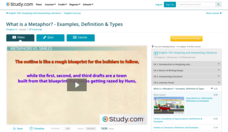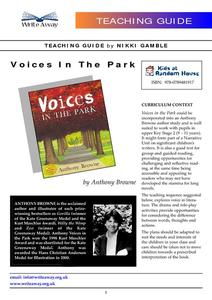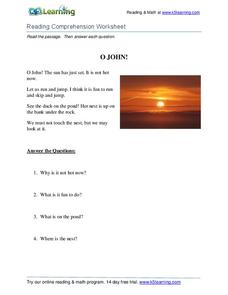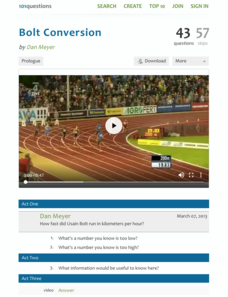Curated OER
The Call of the Wild
Students read The Call of the Wild, noting its theme of survival. They investigate the book's concepts with word webs, spider maps, or graphic organizers. They conduct a panel discussion on dogs and wolves. They write a letter to the...
Curated OER
Finding Problems In A Story
Students categorize information into a problem/solving chart and examine the value of using a diary. In this problem solving and diary instructional activity, students read portions of Dear Mr. Henshaw, while they investigate the...
Kansas Poets
Persona Poem
Young poets are asked to craft a poem in the voice of a first person narrator, a dramatic monologue of sorts, that reveals not only a dramatic situation but something of the narrator's character as well.
National Endowment for the Humanities
Narrative Voice in Moby Dick
Call him a reliable narrator! Ishmael is the focus of a lesson that asks readers to analyze the complex character of Herman Melville's narrator as he is introduced in the first chapter of Moby Dick.
Curated OER
Crane, London, and Literary Naturalism
Learners analyze "To Build a Fire" by Jack London and "The Open boat" by Stephen Crane. They write an essay in which they compare and contrast the narrators and plots in each story.
Curated OER
Characterizations: Indirect and Direct
Connect literature to narrative writing by researching descriptive writing techniques. Elementary and middle schoolers identify the importance of a narrator and voice in the storytelling process. They read writing samples and identify...
Curated OER
Rural Life During the Great Depression: A Year Down Yonder
“Anyone who thinks small towns are friendlier than big cities lives in a big city.” Mary Alice, the fifteen-year-old narrator of A Year Down Yonder, is forced to leave Chicago and spend a year with her Grandma Dowdel in a small rural...
Curated OER
Discussion Web for The Catcher in the Rye
Is Holden Caulfield a reliable narrator? Readers use the provided graphic organizer to record specific textual evidence from The Catcher in the Rye to support their response. A teacher copy of the template is provided.
Scholastic
Study Jams! Finding a Fraction of a Set
Finding a fraction of a number is just multiplication in disguise. Young mathematicians can interact with this lesson to practice using multiplication to find a percent of a whole number. The narrator goes over how to put the number over...
Curated OER
Allusion and Illusion: Definitions and Examples
Illusions and allusions certainly sound similar but there is a world of difference in their meanings. The narrator of this short video distinguishes between these terms, defines them, and offers examples that are sure to engage viewers....
Curated OER
What is a Metaphor? - Examples, Definition & Types
Metaphors, the definition of, types of, and examples of, are the subject of a short video that models for viewers this grand poobah of literary terms. Colorful images and animations are used to illustrate the connections between...
Write Away!
Voices In the Park
Explore the impact a narrator's point of view has on a story with a reading of the children's book, Voices in the Park by Anthony Browne. Written in four different voices, the story is told and retold from different perspectives to...
TED-Ed
The Silk Road: Connecting the Ancient World Through Trade
Introduce learners to The Silk Road, the first world-wide web. The narrator of this short, animated video traces the pioneers of globalization and the impact they had on culture and economy. The Scythians, Darius the First, and Alexander...
National Center for Families Learning
Hidden Flags
Scholars scour a city landscape to locate twenty-five hidden flags. After each discovery, the narrator offers a piece of information about the American symbol. When all flags are found, a fireworks display appears in celebration of a job...
K5 Learning
O John!
As the sun sets, what does the narrator see? After reading brief passage, first graders answer four comprehension questions about what they read.
K5 Learning
Here Ponto
Pronto is a good dog. He saves the narrator's dolls that got into the water and brings them back to the pond's edge. Readers respond to four comprehension questions after reading about Pronto.
Alabama Learning Exchange
Can You Solve the Mystery of the Variable?
Solving a murder is like isolating a variable. Using a video on a murder mystery, the narrator introduces the idea of solving a literal equation for one variable. After solving several equations, the class comes up with a set of...
101 Questions
Bolt Conversion
Usain Bolt and Superman have something in common—speed! A video of one of Bolt's races introduces young scholars to the concept of unit rate. Using data from the race, the narrator calculates a unit rate in kilometers per hour, which...
Reed Novel Studies
The Little Prince: Novel Study
Do our eyes play tricks on us? The Little Prince narrator begins with a discussion of the difference in what grown-ups and children see. Scholars read how he puts this to the test using a drawing and find synonyms to vocabulary words,...
Corbett Maths
Enlargements Using Ray Method
Figure out what to do when there is no grid to count. Using a ruler and a sharp pencil, the narrator shows how to perform a dilation when the figure is not on a grid. The ray method works by drawing a ray from the center of dilation...
Corbett Maths
Enlargements with Negative Scale Factor
How will a scale factor affect a figure—negatively? Using a grid, the narrator of an engaging video performs a dilation with a negative scale factor. The presenter compares a positive scale factor with a negative scale factor to explain...
Corbett Maths
Finding the Centre of Enlargement
Where did the transformation begin? Using a ruler, the narrator of a short presentation shows how to find the center of enlargement for transformed figures. Worksheets provide the class members an opportunity to practice the newly...
Corbett Maths
Coordinates and Shapes
Where is the point? Given three points on the coordinate plane, the video walks through the steps to find the location of the fourth point to create a given special quadrilateral. The narrator first determines the coordinates of the...
Corbett Maths
Constructing SAS Triangles
Two sides and an angle ... a triangle it makes. Given the measure to two sides and the angle between them, the narrator of a short video shows how to draw a triangle with a ruler and protractor. Pupils use handouts to practice the newly...
Other popular searches
- Point of View Narrator
- Author and Narrator
- Unreliable Narrator
- First Person Narrator
- Identify Narrator
- Identifying the Narrator
- Point of View/narrator
- Omniscient Narrator
- Identify Narrator or Speaker
- Narrators Point of View
- Narrator Mask
- Narrator and Voice

























